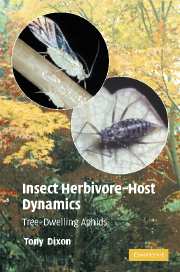Book contents
- Frontmatter
- Contents
- Preface
- 1 Introduction
- 2 Tree-dwelling aphids
- 3 Trees as a habitat: relations of aphids to trees
- 4 Trees as a habitat: relations of aphids to their natural enemies
- 5 Carrying capacity of trees
- 6 Aphid abundance
- 7 Population dynamics
- 8 Risky dispersal
- 9 Seasonal sex allocation
- 10 Aphids and tree fitness
- 11 Rarity, conservation and global warming
- Epilogue
- References
- Species index
- Subject index
1 - Introduction
Published online by Cambridge University Press: 08 August 2009
- Frontmatter
- Contents
- Preface
- 1 Introduction
- 2 Tree-dwelling aphids
- 3 Trees as a habitat: relations of aphids to trees
- 4 Trees as a habitat: relations of aphids to their natural enemies
- 5 Carrying capacity of trees
- 6 Aphid abundance
- 7 Population dynamics
- 8 Risky dispersal
- 9 Seasonal sex allocation
- 10 Aphids and tree fitness
- 11 Rarity, conservation and global warming
- Epilogue
- References
- Species index
- Subject index
Summary
The prodigious rate of increase of aphids has fascinated entomologists for centuries. Réaumur (1737), like Leeuwenhoek, thought aphids were hermaphrodite and calculated that one aphid may give rise to 5.9 billion over a period of six weeks. Bonnet (1745) was the first to appreciate that aphids were bisexual but could produce a succession of broods without males, a phenomenon that later became known as parthenogenesis (Owen, 1849). Huxley (1858) was also fascinated by parthenogenesis in aphids and calculated that after 10 generations, if they all survive, an aphid can give rise to a biomass equivalent in weight to 500 million stout men. Occasionally these extraordinary rates of increase are realized. White (1887), of Selborne, records that at about 3 p.m. on 1 August 1774, showers of hop aphids fell from the sky and covered people walking in the streets and blackened vegetation where they alighted in Selborne and adjoining towns. Similarly, enormous numbers of cereal aphids plagued people in England in 1790 (Curtis, 1845), and in September 1834 an immense cloud of the peach potato aphid swept across the river, covered the quays and streets of Gent, and darkened the sky in both Brugge and Antwerpen (Morren, 1836). Thus, aphids are potentially capable of becoming very abundant over a wide area. Fortunately such plagues are rare. The implication of this is that aphid abundance is normally regulated well below plague levels.
My interest in tree-dwelling aphids started from an observation when experimenting with ladybirds in the field in 1956.
- Type
- Chapter
- Information
- Insect Herbivore-Host DynamicsTree-Dwelling Aphids, pp. 1 - 5Publisher: Cambridge University PressPrint publication year: 2005



